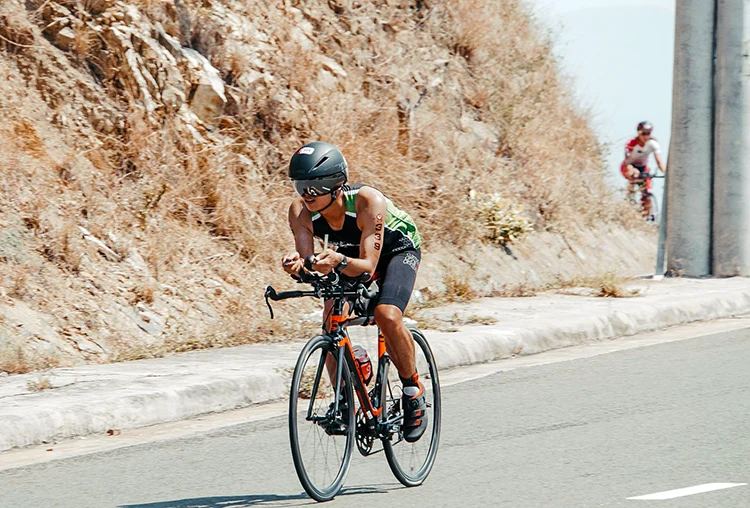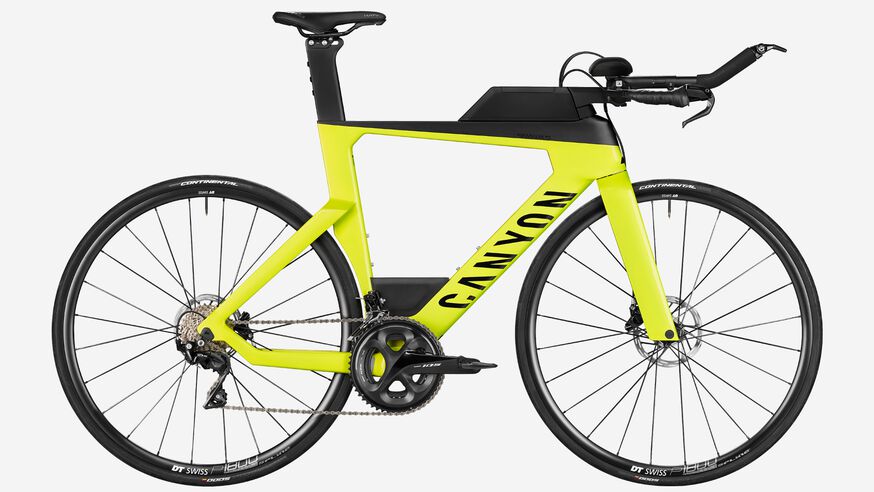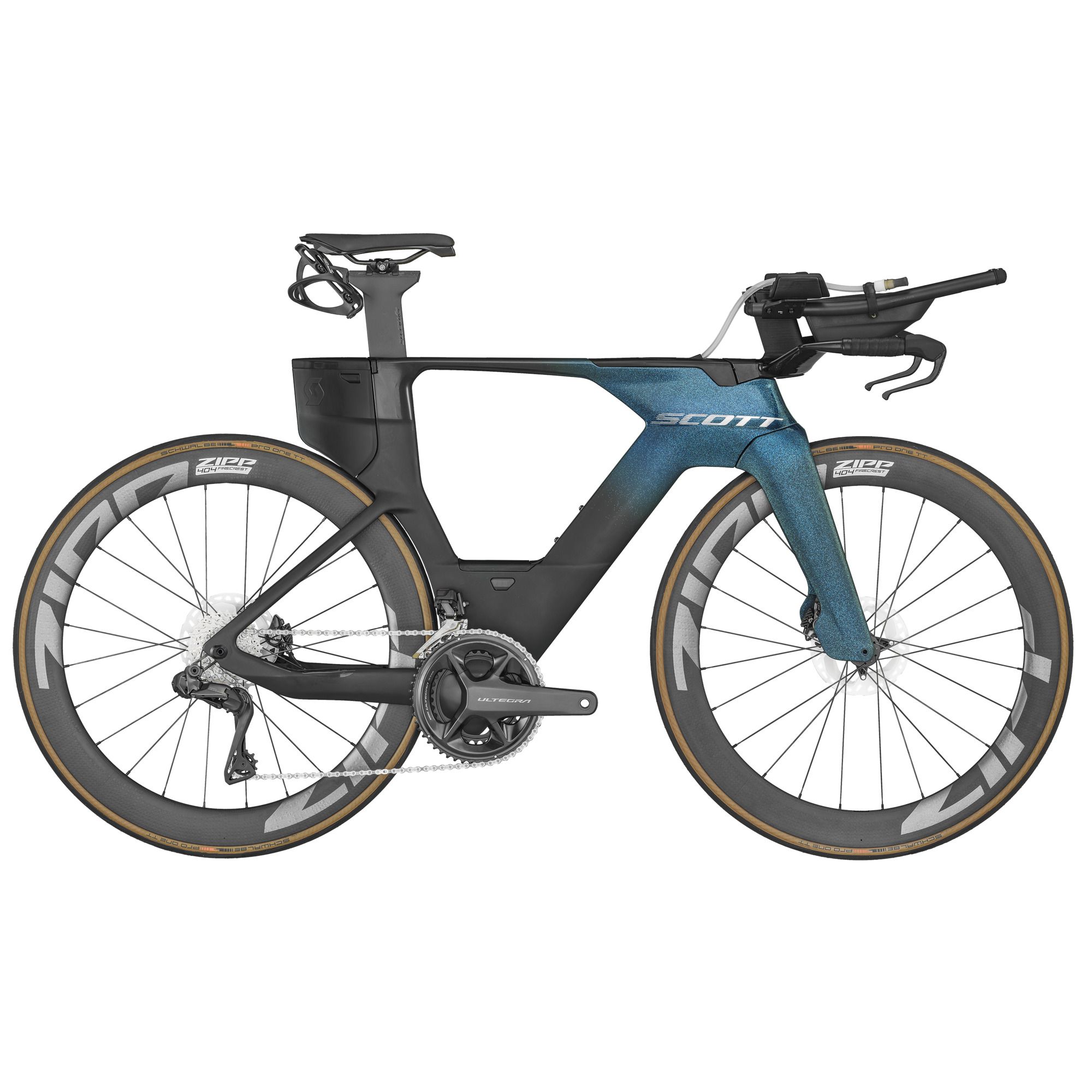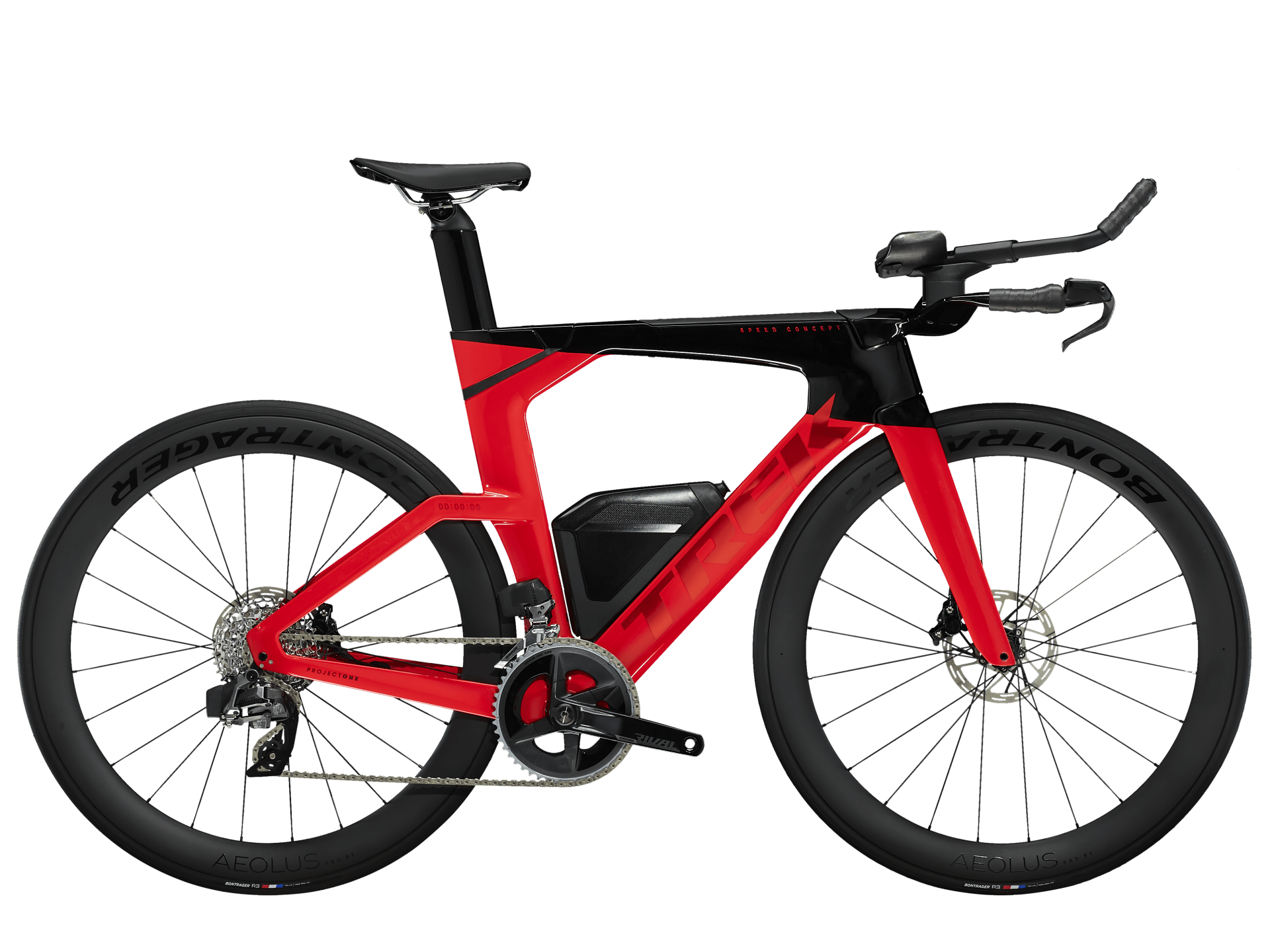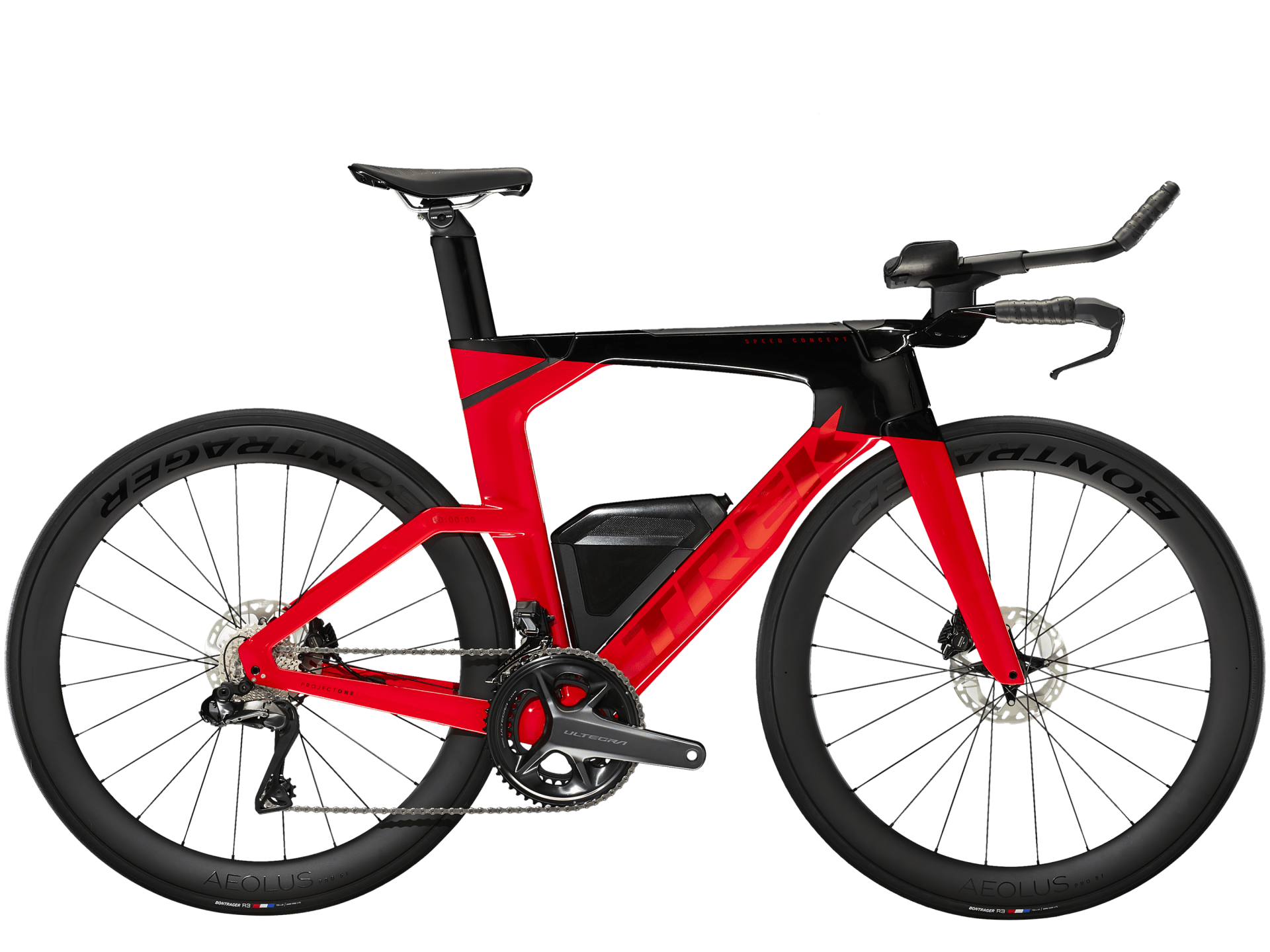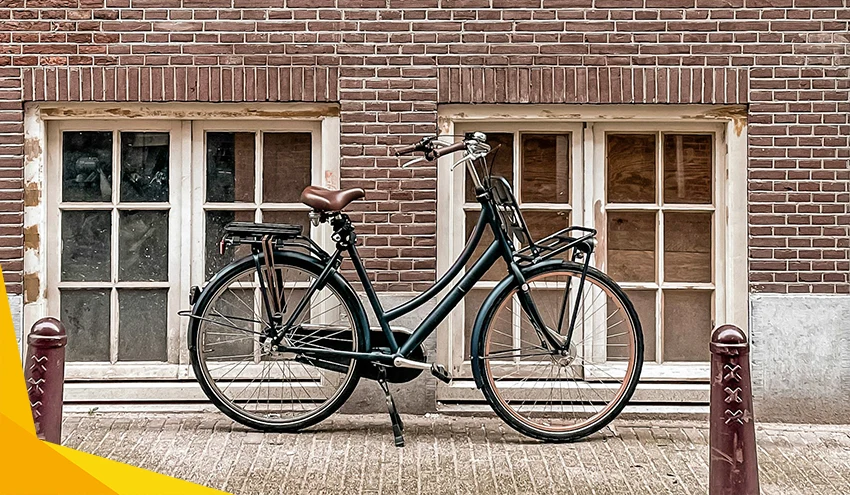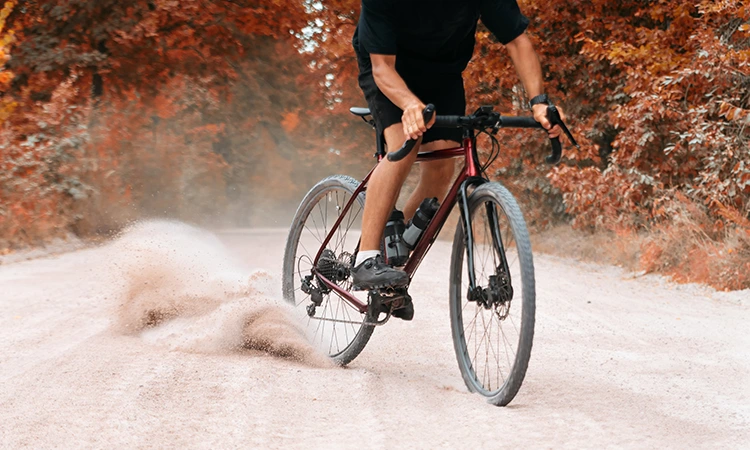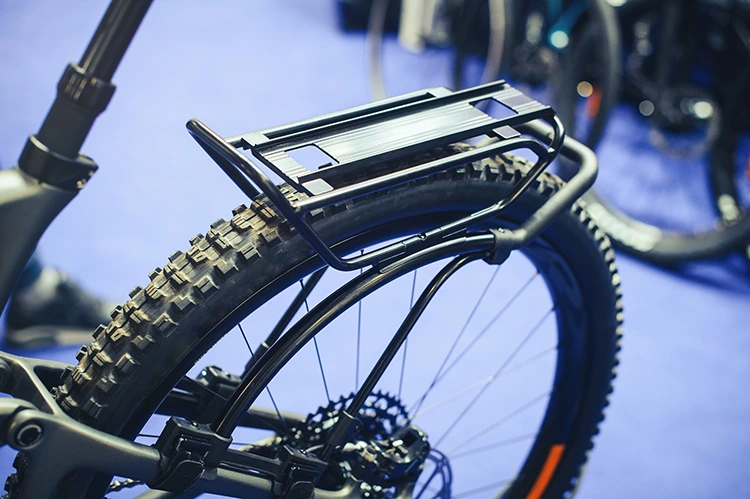From complete newbies to experienced Ironman triathletes, we’ve put together a list of the best triathlon bikes in 2022.
Triathlon bikes look daunting at first sight, but it’s all for a reason.
These aerodynamic frames come with time-trial-specific aero bars, comfortable saddles, and ultra-fast wheels.
Whether you’re training for your first sprint triathlon or trying to qualify for Kona, we might have the perfect triathlon bike for you.
In this article, we’re going to take a closer look at the best triathlon bikes for all levels of triathlon. This includes bikes for triathletes from complete beginners to experienced ago-groupers. These triathlon bikes are suitable for any distance, from a sprint triathlon all the way up to a full Ironman.
Here, we’ve made a list of the best triathlon bikes.
Contents
What Are Triathlon Bikes?
Triathlon bikes are bicycles specifically designed for a triathlon, which is a three-sport endurance event involving swimming, biking, and running. Triathlons range in distance from Sprint to Ironman, which is said to be one of the toughest endurance tests in the world.
The biking portion of a triathlon typically lasts from 20 minutes to six hours and is ridden as an individual effort.
As opposed to criterium or road racing like we see in the Tour de France, triathlon biking is typically an individual time trial where drafting is not allowed. That means that your bike speed is determined by only you – your aerodynamics, power output, and speed.
Most triathlon bike courses are flat and straight, with some (if any) corners or hills to navigate. This is one of the reasons that triathlete bikes are heavier and more aerodynamic than road bikes.
With more aerodynamic tubes and aero bars, triathlon bikes sacrifice some cornering and climbing ability. But on most triathlon courses, the extra straight-line speed is well worth the sacrifice.
In triathlon, the run portion always follows the bike, which means that triathlon bikes need to be comfortable.
You wouldn’t want to step off the bike and go straight into a 10km run with a sore back, cramping glutes, and fiery quads.
Especially in long-distance triathlons (half Ironman and Ironman distances), it is crucial to ride a triathlete bike that is equally fast and comfortable.
That’s why you’ll see extreme-looking saddle and handlebar positions on most of these triathlon bikes. It takes some getting used to, but these triathlon bikes are actually quite comfortable, even while riding in the aero position.
Let’s jump into our list of the best triathlon bikes which includes bicycles for every level of triathlon and which are suitable for any triathlon distance.
Best Triathlon Bikes
Canyon Speedmax CF 7 Disc
Best Overall Triathlon Bike
- Bento box and toolbox included
- Lightweight (9.4kg)
- Crankset includes 4iiii Precision power meter
It is almost impossible to beat the combined value and quality of the Canyon Speedmax CF 7 Disc. Many iterations of the Canyon Speedmax have made their way into the triathlon world in recent years, and the quality continues to rise.
At a fantastic price point, you can get one of the most popular triathlon bikes for beginners and professionals alike. Weighing in at 9.4kg, the Speedmax CF 7 Disc is also lightweight for a triathlon bike, making it a great choice for hilly terrain.
The hardshell Bento box on the top tube is a Canyon Speedmax staple, and it is perfect for storing gels, bars, and more. There is also the practical toolbox located just above the bottom bracket. Its design actually increases aerodynamics while also storing tools and parts like spare tubes or a multi-tool.
Canyon CFD-optimised seat stays further increase aerodynamics, sticking out like wings just above the rear wheel.
This bike comes with a Shimano 105 R7000 4iiii Precision power meter and Selle Italia Watt Superflow saddle, both bargain add-ons at this price point.
The Shimano 105 components decrease the bike’s value, but anyone but elite triathletes will truly be bothered by them. Disc brakes are included, as well as 11-speed shifting and 2X gearing, giving the Canyon Speedmax CF 7 Disc a big range of gearing for hilly routes.
Scott Plasma 6
Best Pro-Level Triathlon Bike
- Shimano Ultegra Di2 components
- Plasma 6 Disc Carbon, HMX frame
- Schwalbe PRO ONE TT TL tires
Scott Plasma 6 is one of the best triathlon bikes in the world for professional-level racing. Its Plasma 6 Disc Carbon, HMX frame has fully integrated cables, a hydration system, and storage boxes.
Built for triathlon-specific speed, the Scott Plasma 6 is perfect for all triathlon distances from sprints to full Ironman.
The frame includes Shimano Ultegra Di2 components and 24 speeds. This gives you tons of range to cover flat terrain, fast downhills, and steep climbs. The entire bike weighs just 9.8kg.
Up front is a Shimano Ultegra 52/36T crankset, while the rear sports an Ultegra 11-30T cassette. Designed with TRI geometry and plasma HMX seatpost, the Plasma 6 is specifically engineered for triathlon.
Schwalbe PRO ONE TT TL tires provide a healthy balance of grip and speed, while the Shimano RT-CL800 160mm disc brake rotors provide plenty of stopping power.
The biggest downside of the Scott Plasma 6 is the price tag. But if you’re a competitive triathlete with a healthy budget, the Scott Plasma 6’s performance is next to none.
Trek Speed Concept SLR 6
Best Race-Ready Triathlon Bike
- SRAM Rival AXS drivetrain
- Tubeless-ready carbon wheels
If you’re an ambitious triathlon or time-trial racer, the Trek Speed Concept SLR 6 is just the tool you need to help you reach your goals. Its frame is made with lightweight carbon fiber, and the aerodynamic frame is built for straight-line speed.
The Speed Concept SLR 6 comes with 700c x 25mm tires, though the frame can fit tires up to 28 mm wide.
As you’d expect from a high-end triathlon bike, the Trek Speed Concept has hydraulic disc brakes and a SRAM Rival AXS electronic drivetrain.
While the carbon frame is great for racing, this triathlon bike also comes with tubeless-ready carbon wheels that are significantly lighter than aluminum wheels.
The Speed Concept’s $9,000 price will appeal to seasoned triathlon bike buyers, or those who are new to the sport but ready to bite the bullet. For beginner triathletes, the carbon fiber frame and triathlon-specific geometry are ideal.
Cannondale SystemSix Hi-MOD Ultegra Di2
Best Road Bike for Triathlon

- Shimano Ultegra Di2 groupset
- Lightweight BallisTec carbon frameset
- HollowGram 64 carbon wheels
Road bikes are perfect for beginner triathletes and cyclists who race more than just triathlon. With drop bars and more relaxed geometry, road bikes are ideal for group rides and road races in addition to triathlons. Cannondale SystemSix Hi-MOD Ultegra Di2 is the classic race machine, according to Cannondale.
Its lightweight, low-drag BallisTec frameset is made of carbon fiber, and the entire bike weighs just 8.2kg, which is lighter than just about every triathlon bike.
Shimano Ultegra Di2 components are present throughout the frame, both reliable and versatile. The SystemSix Hi-MOD comes with 2×12-speed shifting and an 11-30T cassette.
Like top-end triathlon bikes, the Cannondale SystemSix comes with hydraulic disc brakes with 160/140mm rotors, and 25c tires. Specifically, this bike comes with Vittoria Rubino Pro tires which are both grippy and fast.
Overall, the SystemSix has a more relaxed geometry compared to triathlon bikes, which makes it slower in time trials but much more versatile.
You can comfortably spend five hours on the Cannondale SystemSix, whereas you’d be much more limited on a triathlon bike.
The Cannondale SystemSix Hi-MOD is ideal for beginner triathletes and cyclists who don’t want to go all-in on a triathlon-specific bike yet.
Cervelo P 105
Best Value Carbon Triathlon Bike

- Shimano 105 shifting
- Mechanical disc brakes
- Carbon frame and fork
The P Series is Cervelo’s most popular line of triathlon bikes, and for good reason. With three different bikes on offer, there is a range of quality and price points for every level of triathlete. For beginner triathletes, there is the Cervelo P 105.
With a Cervélo All-Carbon frame, the P 105 keeps weight down whilst maximizing aerodynamics, both crucial features for any triathlon bike.
Cervelo P 105 includes Tektro Spyre mechanical disc brakes, providing good value at this price point.
There is a big range of gearing on offer thanks to the Shimano 105 52/36T crankset and 11-30T, 11-speed rear derailleur. This makes the Cervelo P 105 better suited for beginner triathletes.
There is a little bit of weight added on with the Zipp Vuka Alumina handlebars, but the built quality is still high.
Made for triathletes, there are three different nutrition and hydration pockets on the Cervelo P 105: Smartpak 400, Aerobottle 500, and a rear hydration mount.
For competitive triathletes looking for the best starter triathlon bike, the Cervelo P 105 could be the perfect fit.
Giant Defy Advanced 1
Most Versatile Road Bike for Triathlon
- Shimano Ultgera hydraulic disc brakes
- D-Fuse seatpost and handlebars
- Tubeless 700x32c tires
The Giant Defy Advanced 1 is an endurance road bike that is perfect for all types of road riding. Though it is not the fastest in a straight line, it is much more comfortable and versatile than triathlon-specific bikes.
Overall, the Defy Advanced 1 is perfect for beginner triathletes and those who want to explore, train, and race on the same bike.
Giant’s Advanced Composite frame is specifically engineered for endurance road riding, promoting smoothness and comfort on long rides.
Related: Full Review of Giant Bikes
There is even a D-Fuse seatpost and handlebars which absorb shocks and vibrations from the road. For an affordable road bike, these kinds of features are hard to come by.
Impressively, at this price point, the Defy Advanced 1 also has seamless disc brake integration, flat mounts, and 12mm front and rear thru-axles.
The most unique features of the Defy Advanced 1, compared to the other bikes on this list, are its endurance and versatility features.
The frame has huge tire clearance at up to 35mm, and disc-brake integration which helps the Defy Advanced 1 tackle everything from triathlon pavement to gravel mountain roads. Defy Advanced 1 comes with Giant Gavia Fondo 1 tubeless 700x32c tires, and Shimano Ultegra components with 11-speed, 11-34T shifting.
Even at this price point, the Giant Defy Advanced 1 comes with hydraulic disc brakes with 160mm (front) and 140mm (rear) rotors.
Cervelo S5 Force AXS
Best Aero Road Bike for Triathlon
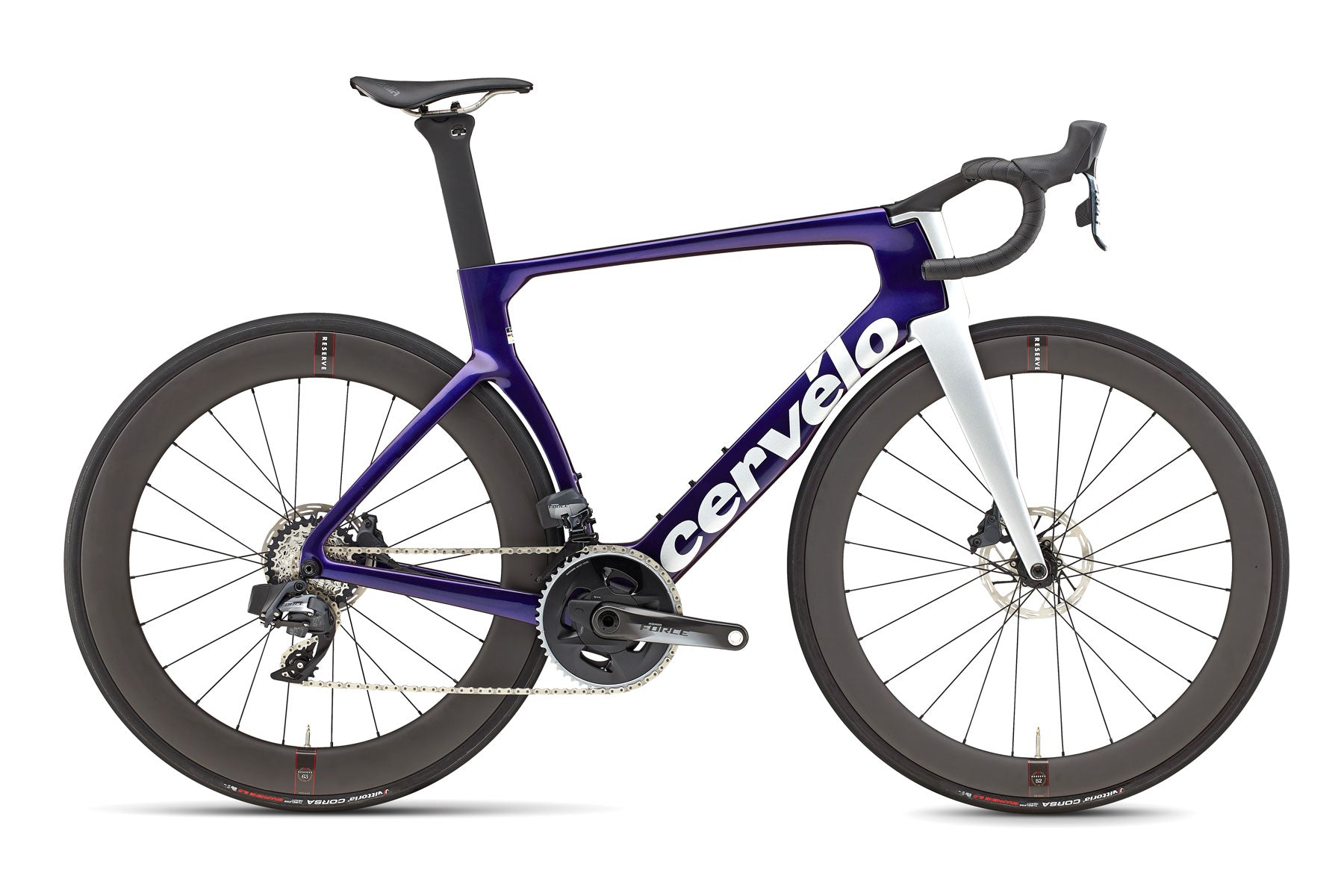
- Lightweight at ~8kg
- SRAM Force AXS components
- Lightweight Cervelo Carbon
The Cervelo C5 Force AXS is perfect for a wide variety of road riding and triathlon.
Its geometry is ideal for fast and long races that benefit from marginal aero gains. A pair of clip-on aero bars can be attached to the handlebars for beginner triathletes looking to improve their straight-line speed.
The Cervelo S5 Force AXS has a frame that uses carbon layups and road race geometry designed for quick reflexes and precise handling.
SRAM Force AXS components offer 10-33T gearing and a 48/35 crankset which is quite small by road bike standards. This is yet another reason that the Cervelo S5 is ideal for beginner triathletes and road cyclists, especially those who are nervous about climbing.
The entire bike weighs about ~8kg, which makes the Cervelo S5 Force AXS the lightest bike on this list by a significant margin.
Vittoria Corsa TLR G 700x28c tires offer a good mix of straight-line speed and versatility, which is why most pro riders ride on 25-28mm tires nowadays. This makes the Cervelo S5 one of the better road bikes for triathlon and competitive group rides.
Trek Speed Concept SLR 7
Best High-End Triathlon Bike
- Shimano Ultegra Di2 drivetrain
- Hydraulic disc brakes
- Smart storage solutions
The best Trek Speed Concept bike available is the SLR 7. This bike has the same Trek carbon frame as the other models in the series but features upgraded components across the board.
This includes Shimano Ultegra Di2 components, which is electronic shifting that is among the best in the business.
The Speed Concept SLR 7 offers 12-speed shifting with an 11-30T cassette, and a 52/36T crankset. This provides a large range of gearing for triathletes, but one that might not be suitable for beginner triathletes on hilly routes.
Out front, the SLR 7 comes with integrated handlebar and stem for a neat aerodynamic cockpit. For fueling, the Speed Concept comes with smart storage that lets you carry fuel without affecting aerodynamics
Finally, powerful hydraulic disc brakes are at the front and the rear of this bike, though you probably won’t use them that much if you’re chasing speed.
How to Choose The Perfect Triathlon Bike
Unless you’re a professional bike mechanic, it can be hard to see the difference between many of the most popular triathlon bikes.
Even among the best triathlon bikes in our list, the differences may seem only marginal. Do 15 grams even make a difference?
When choosing the perfect triathlon bike, there are three things you must consider: aerodynamics, weight, and value.
Your bike’s straight-line speed is arguably its most important feature. Next to that is weight, which matters more or less depending on your training and racing terrain.
Lastly, and most importantly for some, is the value of your triathlon bike. We’ll tell you how to get the biggest splash for cash when choosing the perfect triathlon bike.
Aerodynamics
Triathlon bikes are all about straight-line speed. After your body position (which is crucial for speed), your aerodynamics are next determined by the profile of your triathlon bike’s frame and wheels.
In the triathlon world, the better your aerodynamics, the faster you go. In some cases – windy days, hilly routes, or technical courses – the most aerodynamic frame is not always the best.
But in most triathlons, you’ll want the most aerodynamic triathlon frame and wheels.
Generally, you can look at a triathlon bike and wheels and see how aerodynamic they are.
The more material the better, and the most aerodynamic frames have thick frame tubing, deep sectioned wheels, and a rear disc wheel. This is the fastest straight-line setup that is suitable for most triathlons.
But, as we’ll see in a minute, it’s also the most expensive.
Weight
There was a long-held belief in cycling that lighter was always faster.
And while this is true on an hour-long climb, it is not always true on the flat.
In fact, power and aerodynamics are far more important than the weight on flat roads, which covers the majority of triathlon racing.
During a flat, 40km time trial, it does not matter if your bike weighs 18 lbs or 28 lbs. But as soon as the road tilts up and down, weight becomes a factor.
The steeper and longer the climbs, the more important weight is to triathlon performance. Consider your training roads too: are they flat, hilly, or mountainous?
On hilly or mountainous terrain, a lightweight triathlon bike may be better than a heavier but more aerodynamic triathlon bike. In addition, the faster you go, the more aerodynamics matters than weight.
Thus, beginner triathletes are more apt to use lightweight triathlon bikes, while elite-level athletes will be faster on a heavier aerodynamic frame.
Value
Perhaps the biggest obstacle to purchasing a triathlon bike is the price. While baseline models may cost around $2,000, higher-end triathlon bikes can cost upwards of $10,000 when you include aerodynamic race wheels.
When choosing the perfect triathlon bike, you want to get the biggest bang for your buck. The answer is a combination of your current ability and future triathlon goals.
In the sport of triathlon, the better you are, the narrower the margins are between first and last.
This is when high-end race equipment becomes even more critical when the difference between 1st and 10th could be just a few minutes. For competitive triathletes, it makes sense to invest more into getting the perfect triathlon bike.
But for beginner triathletes, the difference between competitors is more often down to fitness and experience than their equipment choices.
As a beginner or intermediate-level triathlete, you will benefit more from structured training and minor equipment purchases like a new helmet, running shoes, or carbon race wheels.
A special note for long-distance triathletes such as Ironman competitors: due to the extra long training hours, it is best to invest in a triathlon bike right away.
The more time you spend in the saddle, the more important it is that you have an excellent frame, a comfortable saddle, and aero bars that you can spend hours in.
Just as Ironman athletes invest more time into their training, it makes sense to invest more into your triathlon bike to maximize comfort and performance.
Frequently Asked Questions
What kind of bike is best for a triathlon?
Triathlon bikes are the best bikes for triathlons. The only exception would be if you are a complete beginner and have never ridden a triathlon bike before. Riding in the aero bars is an aggressive position that can take some getting used to, so it is better for beginner triathletes to start with a road bike for triathlons.
Most triathlon courses are straight and flat, and there is nothing faster on that terrain than a triathlon bike. If your triathlon course is uniquely hilly or technical, then it may be better to race on a road bike; but this is a rare case.
Is a triathlon bike worth it?
A triathlon bike is worth the cost for competitive triathletes. There is nothing faster in a straight line than a triathlon bike. A road bike with clip-on aero bars is not even close. In order to achieve your fastest times and compete near the top of your category, you need a triathlon bike for triathlons.
If you’re worried about the investment, remember then you can resell your triathlon bike if it doesn’t work out. As long as you keep your triathlon bike in good working condition, you will be able to resell it for a good chunk of the original price.
If in doubt, start with a road bike for your first few triathlons. Then add clip-on aero bars when you’re ready to be more competitive. Once you want to compete for the win, go with a full-on triathlon bike.
Is a road bike OK for a triathlon?
Yes, most triathletes start on road bikes for their first few triathlons. This is because road bikes are more versatile than triathlon bikes, and you can use road bikes for training, racing, climbing, group riding, and more.
When you’re ready to upgrade your racing set-up, you can even start with attaching a pair of clip-on aero bars to your road bike. This allows you to go faster in a straight line without having to invest the time and money into setting up a whole new triathlon bike. But for serious triathletes, there is nothing faster and more comfortable than a triathlon bike.
What’s the difference between a triathlon bike and a road bike?
The main differences between a triathlon bike and a road bike are frame shape and aerodynamics, aero bars, and wheels.
Triathlon bikes have thicker and more aerodynamic tubing than road bikes which are heavier but faster in a straight line. Whereas road bikes have drop bars – handlebars with three available hand positions – triathlon bikes have aero bars which are time-trial-specific handlebars with long extensions for your forearms.
Lastly, triathlon bikes have deep-sectioned wheels and sometimes rear disc wheels which are heavier but faster than shallower road bike wheels which are designed for climbing and all-around riding.
Why do triathletes use TT bikes?
Triathletes use TT bikes, or time trial bikes because triathlons typically involve an individual effort rather than group riding. The only exception is Olympic-style triathlons which allow pack riding; but in these triathlons, racers use road bikes instead of TT bikes.
For individual effort, TT bikes are faster than road bikes. This is because TT bikes are more aerodynamic than road bikes. And during an individual effort, you don’t need to worry about pack riding skills such as braking or positioning.
Is a triathlon bike faster than a road bike?
Yes, a triathlon bike is faster than a road bike on a straight and flat road. Triathlon bikes are much more aerodynamic than road bikes thanks to their unique tube shapes and time-trial-specific handlebars. Though triathlon bikes weigh more than road bikes, there is no significant penalty for increased weight on flat roads.
Road bikes are faster than triathlon bikes when it comes to climbing and descending since road bikes are lighter than triathlon bikes, and they also handle much better in corners.
Why are tri bikes heavier than road bikes?
Triathlon bikes are typically heavier than road bikes because they use more materials. Whereas triathlon bikes are designed for straight-line speed, road bikes are designed for a mix of speed, cornering ability, and climbing. Thus, road bike frames have thinner tubes and less overall material to keep them lightweight. Road bikes typically have lighter and shallower wheels which are lightweight as well as aerodynamic.
On the other hand, triathlon bikes have thicker aerodynamic tubes which use significantly more material than road bikes. Triathlon bikes also have deep-sectioned wheels, and sometimes rear disc wheels, which are super aerodynamic, but also significantly heavier than shallower wheels used on road bikes.

